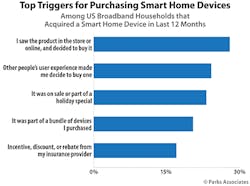Research Results Tell the Story —
Recent findings from Parks Associates’ Smart Home Buyer Journey and User Experience, reveals that adoption of home control systems experienced a 38% year-over-year growth rate. The research firm confirms that 18% of US broadband households have a home control system, and that roughly one-half of households with a home control system purchased their system with their first smart home device. (See Figure 1.)
Figure 1.
The majority of home control systems are integrated into a home security system, indicating the success of the security channel in particular in promoting the value proposition of home systems. The conversion of legacy security subscribers to interactive security services that support smart home automation is driving the increase in home control systems, while adoption of DIY home control systems independent of security has remained flat.
The research shows consumers are most likely to acquire a home control system in the early stage of smart home adoption, with their first or second device, as opposed to a later stage when they own multiple smart home devices. Most consumers do not buy 3 or more smart home products and then look for a system to control all their devices, so migrating consumers from multiple devices to a system is currently a challenge for the industry.
The pattern of home system adoption could change as more households acquire multiple devices. Right now, most smart homeowners use multiple apps to control their devices, but as more become multi-device households, these consumer segments will start to seek out a simple, unified experience.
It appears that smart speakers are serving as a gateway to smart home adoption. In fact, 16% of broadband households purchased a smart speaker prior to purchasing a smart home device. Of the 29% of US broadband households that own both a speaker and a smart home device, nearly three-fourths said ownership of the speaker motivated them to purchase a smart home device. (See Figure 2.)
Figure 2.
Smart speakers can present strong use cases for smart home devices to the consumer. By bundling smart speakers with smart plugs, smart light bulbs, or smart thermostats, companies can deliver a guided introduction to the smart home experience. This combo also helps facilitate support for self-installation, which is becoming significantly more important given the COVID-19 pandemic.
Self-Installs
Parks Associates notes that between 69% and 78% of all smart security and safety devices bought in 2019 were self-installed.
The self-installation trend enables direct-to-consumer online sales for retailers and service providers alike without the cost or challenges of a COVID-19 service call. Prior to the outbreak, the main trigger for a smart home purchase was the consumer experience of seeing the product in a store or online. With so much shopping now shifting online, having these self-install options is even more important to trigger sales, and with a smart speaker, companies can deliver support through do-it-with-me or do-it-together services that utilize real-time chat.
InvisiLight® Solution for Deploying Fiber
April 2, 2022Go to Market Faster. Speed up Network Deployment
April 2, 2022Episode 10: Fiber Optic Closure Specs Explained…
April 1, 2022Food for Thought from Our 2022 ICT Visionaries
April 1, 2022Highlights
Additional highlights of the report reveal:
• Over a quarter of broadband households now own multiple smart speakers.
• 68% of smart thermostat purchasers self-installed the device.
• 45% of recent smart home device buyers did some research prior to making a purchase; 51% did no research.
• 52% of broadband households intend to purchase some kind of smart home device in the next 12 months.
Data Privacy Concerns
Interestingly, cybersecurity is a powerful factor in the equation of smart home adoption. In fact, nearly half of the segment we classify as the smart home disengaged (the 44% of broadband households not owning or intending to purchase any smart home device), cited data privacy and security concerns as a barrier to adoption. This marked a notable increase from the 25% of respondents citing data privacy and security concerns only 12 months prior.
While there is widespread concern among consumers surrounding data privacy, adoption of data security services remains lower than one might expect. This may be a result of a lack of understanding by the consumer as to how their devices function, lack of awareness from consumers about possible solutions, or an expectation that manufacturers are already addressing this problem with devices and additional protections aren’t necessary.
At this point, data security services have yet to be adopted by the majority of consumers, leaving ample room for data security providers to work on ease-of-use, pricing, and marketing. As smart home devices move to mass market adoption, manufacturers, broadband service providers, and data security service providers, must double their efforts to mitigate potential risks to consumers’ personal data without the expectation that the consumer should or will do it themselves.
Findings
Parks Associates finds:
• 40% of broadband households experience security/privacy-related problems with their connected devices annually.
• Among all IoT-related security breaches, malware tops the list.
• Other top breaches include man-in-the-middle attacks and brute force attacks.
• The more security/privacy-related problems a consumer experiences, the more likely they are to be "very concerned" about similar problems.
• An increasing problem is the suspicion that a data or device breach has happened but the user may not know for certain.
In addition to computing devices (computers, tablets and smartphones), nearly 40% of broadband homes report ownership of at least 1 smart home device that can be remotely accessed or monitored.
Furthermore, technological advances in artificial intelligence (AI) and cloud-managed services have become increasingly important. New technologies are enabling security solutions that are more robust, more cost-effective for providers and consumers, and more easily administered. Network security that can bundle security for endpoints and IoT edge devices, online browsing and network traffic, mobile protection, and parental controls, are at the leading edge of security technology.
Advanced Applications
The most advanced applications of AI to consumer security include:
• Advanced device detection via behavioral analysis.
• Assignment of devices to user profiles for increased personalization.
• Behavioral analysis of net traffic for both reactive and proactive defense against malware, phishing, botnets, and untrustworthy websites.
• Advanced digital parenting tools that provide improved app usage information, textual analysis to detect cyberbullying, and content filtering.
Approximately one-half of smart home device owners find a service that protects against being monitored and controlled by unauthorized people "very" appealing. Similarly, just over 40% of computing and entertainment device owners find a service that protects their device from malicious viruses and software "very" appealing.
Like this Article?
Subscribe to ISE magazine and start receiving your FREE monthly copy today!
Resources and Notes
For more information about Parks Associates’ consumer study Smart Home Buyer Journey and User Experience, published 2Q 2020, please visit http://parksassociates.com/marketfocus/smart-home-journey. The study provides critical intelligence for smart home business strategies with data on smart home trends influencing consumer purchase behaviors and preferences. Topics include smart product adoption and purchase intentions across multiple product categories, segmentation profiles, purchase channels and installation preferences, voice and control platforms, app engagement, reliability and satisfaction scores by category, product feature interests, and attitudes about data security, interoperability, and support.











